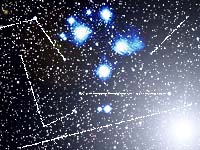 The word, "Astronomy" comes from a combination of two Greek words: astron meaning "star" and nemein meaning "to name". Even though the beginnings of Astronomy go back thousands of years beofre the ancient Greeks began studying the stars, the science of Asstronomy has always been based on the similar priniciple of "naming the stars".
The word, "Astronomy" comes from a combination of two Greek words: astron meaning "star" and nemein meaning "to name". Even though the beginnings of Astronomy go back thousands of years beofre the ancient Greeks began studying the stars, the science of Asstronomy has always been based on the similar priniciple of "naming the stars". Many of the names originated from the Greeks, since they were the FIRST Astronomers to make a systematic catalogue of all the stars they could see. (Isn't that interesting......!)
From here, we can see that astronomy is actually one of the oldest of the natural sciences, dating back to antiquity, with its origins in the religious, mythological, and astrological practices of pre-history: vestiges of these are still found in astrology, a discipline long interwoven with public and governmental astronomy, and not completely disentangled from it until a few centuries ago in the Western World.
 In the early times, ancient astronomy used to be involved in observing the regular patterns of the motions of visible celestial objects, especially the Sun, Moon, stars and naked eye planets. An example of this early astronomy might involve a study of the changing position of the Sun along the horizon or the changing appearances of stars in the course of the year, which could be used to establish an agricultural or ritual calendar. In some cultures astronomical data was used for astrological prognostication.
In the early times, ancient astronomy used to be involved in observing the regular patterns of the motions of visible celestial objects, especially the Sun, Moon, stars and naked eye planets. An example of this early astronomy might involve a study of the changing position of the Sun along the horizon or the changing appearances of stars in the course of the year, which could be used to establish an agricultural or ritual calendar. In some cultures astronomical data was used for astrological prognostication.In addition, a number of early civilisations remembered the relative positions of the stars by putting together groups that seemed to make patterns in the night sky. One of these might look like a curling river, so it was called Eridanus which is known as "the great river" in Greek. Another example will be the position of stars which look like a hunter with a bright belt and dagger. This is position of stars is actually called Orion, the hunter.
* Interesting facts......!
 Do you know that the earliest astronomers were actually shepherds who watched the heavens for signs of the changing seasons! Those clear nights would have given them the opportunity to recognize familiar patterns and movements of the brightest heavenly bodies.
Do you know that the earliest astronomers were actually shepherds who watched the heavens for signs of the changing seasons! Those clear nights would have given them the opportunity to recognize familiar patterns and movements of the brightest heavenly bodies.Ancient astronomers were able to differentiate between stars and planets, as stars remain relatively fixed over the centuries while planets will move an appreciable amount during a comparatively short time.
In ancient times, early astronomers realised that these repeating motions in the cyclic motion of the Sun, the Moon and the stars could actually be used to fashion the sky into a "living" clock (to tell the passage of the hours of the day or night) and a calendar (to mark the progression of the seasons). Ancient monuments, such as Stonehenge in UK and the pyramids of the Maya in Central America, provide evidence that the basic components of observational astronomy have been known for at least 6000 years! Ancient structures with possibly astronomical alignments probably fulfilled both astronomical and religious functions.
 With only a few exceptions, almost all civilisations have believed that the steady movements of the sky were some sort of signal of greater plan to them.
With only a few exceptions, almost all civilisations have believed that the steady movements of the sky were some sort of signal of greater plan to them. Fun time......!
After reading my posts on Astronomy, I'm sure you have an idea of what is Astronomy. To deepen your understanding, let learn it in an interesting way through games & crossword puzzles!
To play the game, "Make-A-Planet", please click the link below:
References:
- http://www.astro.virginia.edu/class/oconnell/astr121/guide05-s04.html
- http://en.wikipedia.org/wiki/History_of_astronomy
- http://www.blogcatalog.com/blog/easy-astronomy-blog
- Astronomy - Eyewitness Guide
- Written by Kristen Lippincott




0 comments:
Post a Comment